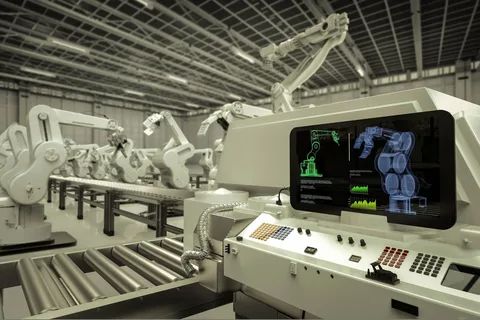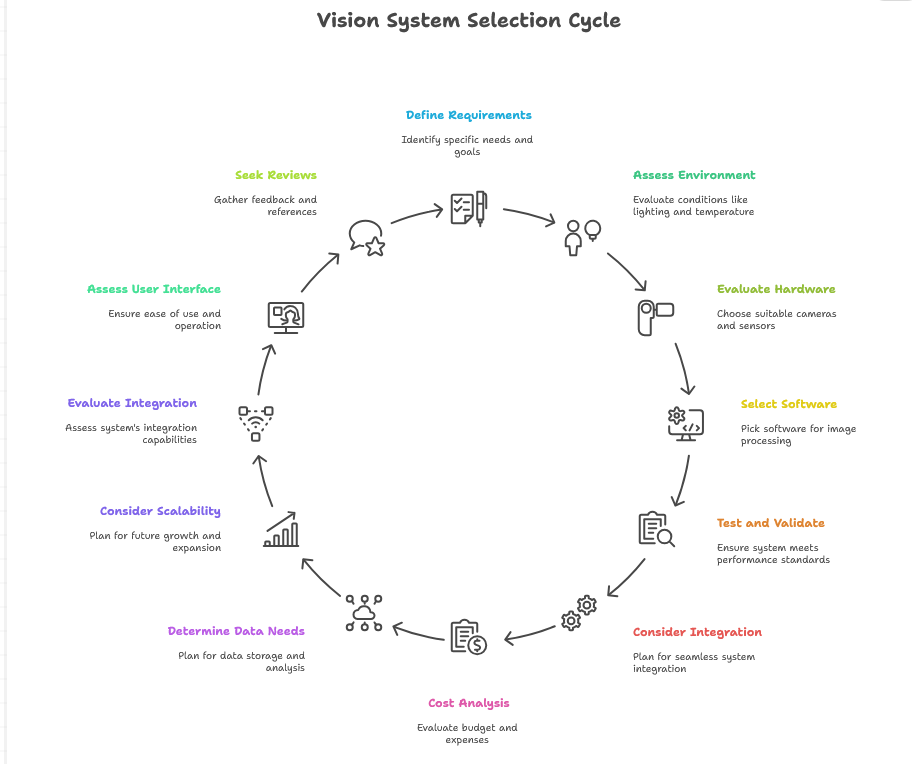In today’s fast-paced and technology-driven world, vision systems have become an integral part of various industries, ranging from manufacturing and automation to healthcare and security. These sophisticated systems, powered by advanced algorithms and cutting-edge hardware, enable machines to perceive and interpret their surroundings with incredible precision.
However, with an array of options available in the market, selecting the right vision system can be a daunting task. To ensure optimal performance and maximum return on investment, it is crucial to understand the key factors that influence the selection process. In this comprehensive guide, we will delve into the essential considerations that will help you choose the perfect vision system tailored to your specific needs.

What Is a Vision System?
| Aspect | 2D Vision System | 3D Vision System |
| What it captures | Flat images | Depth and 3D shapes |
| Best for | Simple surface or label inspection | Complex shape or size measurement |
| Accuracy | Good for flat objects | Very high for detailed inspections |
| Cost | More affordable | More expensive |
| Setup | Easy and quick | Needs calibration and expertise |
A vision system is an advanced technology that enables machines or computer systems to perceive and interpret visual information from their surroundings. It utilizes cameras, sensors, and image processing algorithms to capture, analyze, and understand visual data, mimicking the human visual system in some aspects.
Vision systems are widely used in various fields, including robotics, industrial automation, quality control, surveillance, and autonomous vehicles. Listed below are the key features of a vision system:
- Image Capture: Vision systems use high-resolution cameras or sensors to capture images or video frames of the target environment or object. These images serve as the input data for further analysis and processing.
- Image Processing: Vision systems employ sophisticated algorithms to process the captured images and extract meaningful information. This involves tasks such as image enhancement, filtering, segmentation, pattern recognition, and object tracking.
- Object Detection and Recognition: A crucial feature of vision systems is the ability to detect and recognize objects within images or video streams. This involves identifying specific shapes, patterns, or features that correspond to known objects or classes of objects.
- Measurement and Dimensioning: Vision systems can accurately measure distances, sizes, angles, and other physical attributes of objects within the captured images. This capability is valuable in manufacturing, quality control, and inspection applications.
- Optical Character Recognition (OCR): Vision systems equipped with OCR capabilities can read and interpret text or characters within images. This allows them to extract information from documents, labels, or signage, enabling automated data entry and analysis.
- Real-time Processing: Vision systems often operate in real-time, allowing for quick and immediate analysis of visual data. This capability is essential in applications that require fast decision-making or rapid response, such as autonomous vehicles or quality control on a production line.
- Motion Tracking: Vision systems can track and follow the movement of objects within the captured images or video. This feature is beneficial in applications like video surveillance, sports analysis, or robotics.
- Color Analysis: Vision systems can analyze and extract information about colors within images, enabling color detection, sorting, or quality control in industries such as food processing or textile manufacturing.
- 3D Vision: Some advanced vision systems incorporate depth perception, allowing for the reconstruction of three-dimensional representations of objects or environments. This capability is valuable in applications like 3D modeling, virtual reality, or robotics.
These key features collectively enable vision systems to automate visual inspection, enhance situational awareness, enable intelligent decision-making, and perform complex tasks that require visual perception and interpretation.
Steps for Choosing The Right Vision System

Choosing the right vision system is crucial for any application that requires automated visual inspection, object recognition, or quality control. A vision system is a combination of hardware and software components that work together to capture, process, and analyze images or videos. Here are the steps you can follow to select the right vision system for your needs:
- Define your application requirements: Begin by clearly understanding your specific application requirements. Identify the objects or features you need to inspect, measure, or recognize. Determine the necessary speed, accuracy, and resolution needed for your system.
- Assess the environmental conditions: Consider the environmental factors that may affect your vision system. Factors such as lighting conditions, temperature, humidity, and vibration can impact the performance of the system. Ensure the chosen vision system can operate reliably in your specific environment.
- Evaluate hardware options: Research and evaluate different hardware options available for vision systems. This includes cameras, lenses, lighting, and other necessary components. Consider factors such as image quality, resolution, field of view, connectivity options, and compatibility with your existing infrastructure.
Refer to Cognex Vision Systems for examples of industrial cameras and inspection systems.
- Select appropriate software: Look for software that suits your application requirements and is compatible with the hardware components you have chosen. The software should offer features such as image processing, pattern recognition, and analysis tools. Consider the ease of use, flexibility, and scalability of the software.
- Test and validate: Before finalizing your vision system, perform thorough testing and validation. Use sample images or objects to simulate real-world scenarios and verify the system’s performance. Evaluate factors such as accuracy, repeatability, and reliability.
- Consider integration and support: Ensure that the vision system can be seamlessly integrated into your existing automation or production line. Check for compatibility with your programmable logic controllers (PLCs) or other control systems. Also, consider the availability of technical support, documentation, and training resources from the vision system provider.
When planning integration, review IEEE Standards for interoperability and data exchange in automated systems. Ensuring compatibility with international protocols helps your vision system scale easily.
- Cost analysis: Finally, consider the overall cost of the vision system, including hardware, software, installation, and maintenance. Balance your budget with the desired performance and functionality of the system. Factor in the long-term benefits and potential return on investment (ROI) that the system can provide.
- Determine data storage and analysis requirements: Evaluate your data storage and analysis needs. Consider factors such as the volume of images or videos that the system will generate, the required storage capacity, and the ability to analyze and extract meaningful insights from the collected data. Assess if the vision system has built-in data management and analysis capabilities or if it can integrate with your existing data infrastructure.
- Consider scalability and future expansion: Anticipate future needs and assess the scalability of the vision system. Determine if the system can handle increased production volumes, additional inspection requirements, or integration with other systems. Consider if the vision system provider offers upgrade paths, modular components, or flexible configurations to accommodate future expansion.
- Evaluate system integration capabilities: If your vision system needs to interact with other equipment or systems, evaluate its integration capabilities. Assess if the system supports common communication protocols and interfaces, such as Ethernet/IP, Modbus, or OPC UA. Ensure compatibility with your existing automation infrastructure to facilitate smooth integration and data exchange.
- Assess user interface and ease of operation: Consider the user interface (UI) and ease of operation of the vision system. A user-friendly interface and intuitive controls can simplify system setup, calibration, and routine maintenance tasks. Look for features such as graphical programming environments, real-time monitoring, and easy parameter adjustments to streamline operation and minimize downtime.
- Seek references and customer reviews: Research the reputation and customer feedback of the vision system provider. Seek references or case studies from companies that have implemented similar systems. Consider customer reviews, testimonials, and ratings to gauge the reliability, performance, and customer support offered by the provider. This information can provide valuable insights into the overall satisfaction of other users.
By following these steps, you can make an informed decision when choosing the right vision system for your specific application. Remember to consider your unique requirements, evaluate hardware and software options, test and validate the system, and assess the integration and cost factors to ensure a successful implementation.
Conclusion
In conclusion, we can say that choosing the right vision system for your needs requires careful consideration of several factors. Firstly, you must clearly define your application requirements and desired outcomes. Then, evaluate the system’s features, such as image resolution, speed, and accuracy, to ensure they align with your needs.
Consider factors like scalability, ease of integration, and support offered by the manufacturer or supplier. Additionally, seek feedback from other users and explore case studies to gauge the system’s reliability. Qodnext, a leading provider of vision systems, can assist you in this process.
Their expertise, wide range of solutions, and dedicated customer support make them an ideal partner to help you navigate the complexities of selecting the right vision system for your specific requirements. Contact Qodnext today for a consultation and take the first step towards enhancing your vision-based applications.
FAQs
1. What is a machine vision system?
A machine vision system is a combination of cameras, sensors, and intelligent software that enables computers or machines to capture and analyze visual information. It’s commonly used for automation, inspection, and quality control in industries.
2. What are the main components of a vision system?
A typical vision system consists of cameras or sensors, lenses, lighting units, image processors, and specialized software that analyzes images, detects patterns, and identifies defects or features.
3. How do I choose between a 2D and a 3D vision system?
Choose a 2D vision system for simple surface inspections, barcode reading, or label verification. If your application requires depth, object volume, or precise measurements, go for a 3D vision system.
4. Which industries commonly use vision systems?
Vision systems are used across multiple sectors — manufacturing, logistics, healthcare, food processing, electronics, and automotive — wherever accuracy and quality assurance are essential.
5. How do vision systems improve quality control?
They automatically detect defects, verify dimensions, and ensure consistency in production. This minimizes human error, increases speed, and enhances product quality.
6. What factors affect the performance of a vision system?
Lighting conditions, camera resolution, lens quality, environmental factors like vibration or dust, and the accuracy of image processing algorithms all influence system performance.
7. Can a vision system integrate with existing automation systems?
Yes. Most modern vision systems support standard communication protocols such as Ethernet/IP, Modbus, and OPC UA, making them easy to integrate with existing PLCs, robots, or IoT-based setups.
8. What are the benefits of using AI in vision systems?
AI enables vision systems to learn and adapt over time, improving defect detection, enhancing pattern recognition, and providing faster, more accurate results even in complex or changing environments.
9. How much does a vision system cost?
Costs can range between ₹2 lakh to ₹50 lakh or more, depending on factors like camera quality, number of inspection points, processing speed, and software capabilities.
10. Who provides reliable vision system solutions in India?
QodeNext India Pvt. Ltd. is a trusted provider of advanced vision system solutions. They offer AI-powered and customizable systems designed for traceability, automation, and industrial performance improvement.







